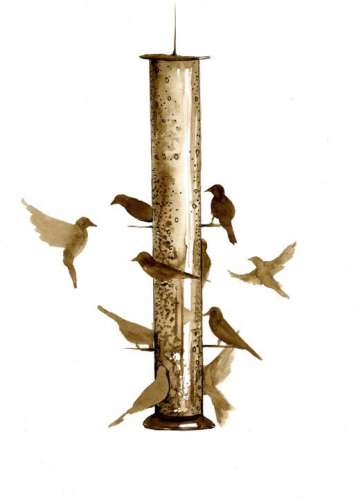
Each winter morning, like thousands of other New Englanders, my wife and I feed the birds before we feed ourselves. For us, it’s like a field trip around the property as we restock two sunflower feeders, a cage for suet, a peanut-butter-and-suet stuffed “log,” a heated water basin, a thistle-seed feeder, and several outlying brushy areas where we scatter cracked corn and millet.
The usual suspects arrive – chickadees, blue jays, downy and hairy woodpeckers, nuthatches and goldfinches – but each winter also brings some birds down from the arctic, such as pine siskins and redpolls. From the south have come cardinals, tufted titmice, and, last year, a red-bellied woodpecker. The once-abundant evening grosbeaks have not been here in years. Occasionally a hawk zooms in, attracted to what we’re attracting.
We feed the birds because, of course, we love the activity and splashes of color they bring during this spartan time of year. My wife records in her watercolor journal what we see, and I usually watch the goings-on from a comfortable observation post, the sofa.
In the past 20 years or so, bird feeding has grown enormously. Millions of Americans now engage in it, making it almost as popular as gardening as a backyard activity. A $3-billion industry has grown around it – from farms producing seed to companies making and selling feeding equipment. A million tons of seed and grain are sold each year in this country for feeding wildlife – mostly birds.
No question birds delight both young and old. Many birders say their interest in birds began by looking out the window. Thanks to observations of activity in backyard feeders over the years, a large database of information is growing, helping ornithologists study species decline and geographical range shifts.
This is all to the good, but as I feed the birds I also wonder whether I’m doing a good thing. Am I a kind of zookeeper, who is turning wild birds into pets, undermining their ability to survive on their own? By encouraging unnatural concentrations of them for our viewing pleasure, are we skewing more normal relationships, even allowing some species to survive where they otherwise wouldn’t? Are we helping to spread bird diseases?
I’m not alone in my questioning. Some research scientists and conservationists think feeding is harmful to birds in a variety of ways. (An article titled, “Crying Fowl: American Backyard Feeders May Do Harm to Wild Birds,” appeared in “The Wall Street Journal,” Dec. 27, 2002). Others, however, including John Fitzpatrick, director of the renowned Cornell Lab of Ornithology, strongly feel just the opposite. He believes that the data indicate feeding is largely beneficial (“In Defense of Bird Feeding” in “Birdscope,” Vol. 17, # 2, 2003).
The debate over the affect on birds notwithstanding, I have other concerns. As great mounds of discarded seed husks emerge around our yard at the end of winter, I wonder how many acres of monoculture it takes to produce all this. Did the acres of cultivated fields replace a more natural environment? How much pesticide was used to produce the seeds we lug home in 50-pound bags?
I see other drawbacks. Wild mice and red squirrels, sustained by pilfered feeder seeds, share our house with us. Each year I fill holes that woodpeckers have drilled into our wood siding. I shoo away cats staking out the feeder or shrubs. Deer by the droves come at night for seeds on the ground, and wild turkeys, 30 at a time, churn up our lawn.
With an increase in year-round feeding across the region, black bears in summer have learned about the treasure-troves in feeders and garbage pails on porches. This has lead to many human-bear encounters and the occasionally killing of a marauding bear.
And all too frequently, my wife and I hear the sickening thud that tells us yet another victim has hit a window. Nationwide, several hundred million birds die each year by striking windows – mostly on skyscrapers during migration, but also on houses.
I even worry about my viewing from the sofa. Am I may becoming a tad more complacent about getting outside? Perhaps this preoccupation with bird-feeding is just another mindless substitute for a television program.
But even if I wanted to stop, I don’t think the birds would let me. If I’m outside and forget to load the feeders, the chickadees fly at me and chatter in my face. Or if I’m inside and late to serve breakfast, they’ll bat themselves against the window. Once, as I was bringing in firewood, one lit on my hand; I dropped the wood and walked around the house to the feeder, and there it was … waiting for me. The woodpeckers, too, are demanding – they rat-a-tat against the house when the suet cage is empty. No, the birds wouldn’t let me stop. They have me well trained.


Discussion *